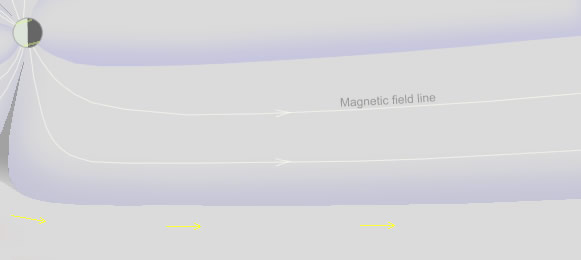
OPOD
What's New
Rays & Shadows
Water Droplets
Rainbows
Ice Halos
High Atmosphere
Nacreous Clouds
Noctilucent Clouds
Rocket Trails
Airglow
Aurora
Magnetism
Glowing Gases
More Images
Zodiacal Light
Links & Resources
Search - Index
123456789012345678
| Magnetosphere and Magnetism |
|
The particles are mainly ionised hydrogen (protons) and electrons plus a few helium and heavier ions. This is the 'solar wind' and it flows continuously*. Solar flares, coronal mass ejections (CMEs) and coronal holes that are directed towards Earth substantially strengthen the solar wind and these are the real aurora makers. The wind is a ‘plasma’, it is an overall electrically neutral mixture of positive and negatively charged particles. Plasmas trap magnetic fields and the solar wind carries not only particles to earth but also the sun’s magnetism. Earth’s magnetic field, generated in its rotating and turbulent outer core of molten iron, is close to sea level like that of a bar magnet. Further out the impact of the solar wind and sun's magnetism distorts it. The solar wind is supersonic and on Earth’s sunward side it produces a shock wave, the bow shock, where it first impacts Earth’s magnetic field and is abruptly slowed. Inside the bow shock the now subsonic wind particles flow around the earth’s magnetic field but the sun’s magnetism still trapped in the plasma interacts strongly. It pushes the Earth’s sunward field inwards and drags the night side out into a tail more than a million kilometres long. The region dominated by the sun’s magnetism is the magnetosheath. The inner region where Earth’s magnetism rules is our magnetosphere. The boundary is the magnetopause. In the steady wind from a quiescent sun particles cannot get inside the magnetosphere. A few leak in but that is all. Aurorae need stronger magnetic interactions - reconnections. When the sun’s trapped field points southwards** it is opposite in direction to that of the sunward field of the earth. When strengthened by a flare or CME it can interact strongly with Earth's field. The opposed fields snap and reconnect to a lower energy state. The sun’s and earth’s fields are now linked and there is a hole in the sunward side of the magnetosphere - an open path through which solar particles can flow inside. The joined sun-earth magnetic field is still trapped in the moving solar wind plasma and it is swept with its particles onwards to the earth’s night side and into the tail of the magnetosphere. There the magnetic filed is increasingly stretched and the trapped particles fill a long inner tail of the magnetosphere called the plasma mantle. Another magnetic filed reconnection or rearrangement ultimately produces the aurora. The long stretched field of the magnetotail is unstable. The stretched field lines snap like elastic bands and rearrange to form two regions, one controlled purely by the earth’s field and one that is part of the solar wind again. The earth's part contracts rapidly accelerating its trapped particles towards us. The final twist, or rather corkscrew, is that the trapped particles follow spiral paths around the magnetic field lines as they accelerate towards Earth. Some feed the equatorial radiation belts. Others spiral along field lines joining the polar ovals. These eventually plunge into the upper atmosphere to make aurorae. However, because the particle clouds in the contracting fields can equally go northwards or southwards along a field line connecting both ovals (and some particles oscillate between the two), the resulting Aurora Borealis and Aurora Australis are mirror images of each other.
|





